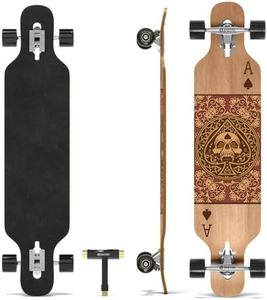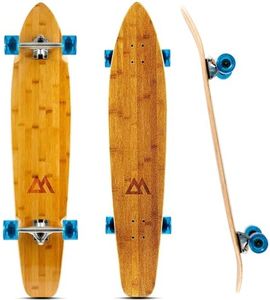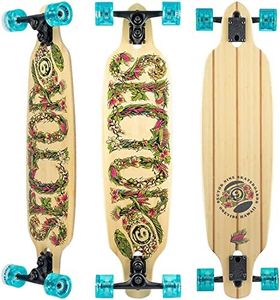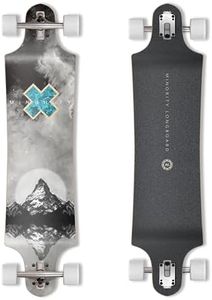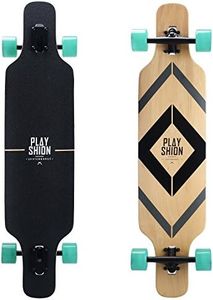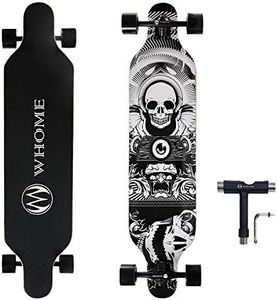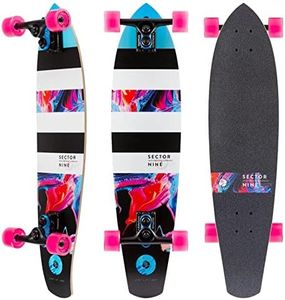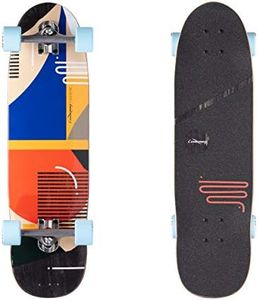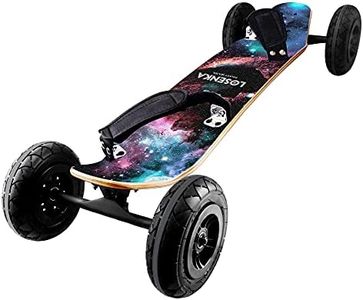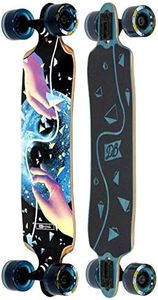We Use CookiesWe use cookies to enhance the security, performance,
functionality and for analytical and promotional activities. By continuing to browse this site you
are agreeing to our privacy policy
10 Best Longboards
From leading brands and best sellers available on the web.Buying Guide for the Best Longboards
Choosing the right longboard is all about understanding how and where you plan to ride. Whether you want to cruise along boardwalks, commute through the city, carve down hills, or learn tricks, there's a longboard out there tailored to your style. Knowing your primary use will point you towards the right board shape, size, and feature set. Think about your experience level and comfort, how portable you need the board to be, and what terrain you'll ride most often. By focusing on the key features that suit your needs, you can find a board that feels just right every time you step on it.Deck ShapeThe shape of a longboard deck impacts how the board handles and feels under your feet. There are symmetrical (often called 'twin') and directional shapes. A symmetrical deck is great if you want to ride both ways, ideal for tricks or freestyle riding. Directional decks, on the other hand, are designed to go mainly in one direction and work well for cruising and downhill riding. Pick a shape that matches your riding intentions: symmetrical for versatility and tricks, directional for speed and stability.
Deck LengthThe length of a longboard deck affects stability, maneuverability, and portability. Longer boards (around 40 inches and up) offer greater stability, making them ideal for beginners, cruising, and downhill rides. Shorter boards (about 32–39 inches) are more agile and easier to carry, suitable for commuting and tighter turns. If you want comfort and stability, prioritize a longer board; for nimbleness and easy carrying, a shorter one is better. Your height and shoe size also play a role—taller riders may feel more comfortable on longer boards.
Deck FlexDeck flex refers to how much the board bends under weight. A flexible deck soaks up bumps and makes for a smooth, comfortable ride, perfect for cruising. Stiffer decks, on the other hand, offer more control under higher speeds and are preferred for downhill or freeride styles. Mid-flex boards strike a balance between comfort and control. Choose your flex based on riding style: go flexible for easy cruising, stiff for speed, and mid-flex if you want a blend of both worlds.
Wheel Size and HardnessLongboard wheels come in various sizes and hardness (durometer), influencing speed, grip, and smoothness. Larger diameter wheels (typically 70mm and up) roll over cracks and rough surfaces easily, offering a smoother ride and more speed, while smaller ones accelerate faster but can get stuck on bumps. Softer wheels (78A–87A durometer) grip the road and absorb vibrations, ideal for cruising and rougher pavement. Harder wheels (88A and above) slide easily and are better for tricks or smoother surfaces. Pick wheel specs that fit your main riding surfaces: bigger and softer for comfort and grip, smaller and harder for tricks and speed on smooth roads.
Truck Type and WidthLongboard trucks are the metal parts that attach the wheels to the deck and affect turning and stability. Reverse kingpin trucks are common on longboards, offering stability for cruising and carving, while traditional kingpin trucks are found on skateboards or shorter cruisers. Truck width should match your deck’s width for balance and smooth turning. Wider trucks (close to the deck width) provide stability, good for downhill and beginners; narrower trucks make for sharper turns suitable for carving or freestyle. Consider riding goals—choose wider for steady, chill rides and narrower for more agile carving.
Deck Material and ConstructionMost longboards are made from layers of wood like maple or bamboo, and sometimes include materials like fiberglass for extra strength or flex. Maple is sturdy and stiff, suitable for speed and heavier riders. Bamboo offers lightness and flexibility, making rides feel springy and comfortable for cruising. Some decks use composites for strength and minimal weight. Consider material based on your need for strength, weight, and ride feel—go for maple if you want durability and speed, or bamboo/composites for lighter, more flexible rides.
